Following the decision this week to end the WSL prematurely, a number of teams will be worried about their futures, with relegation in particular yet to be decided. Bristol City Women may have had a disappointing season overall, but their transfers have been one of the best in the league in terms of adding players that made a difference. Striker Ebony Salmon was one such signing and has been their top scorer this season, and New Zealand midfielder Olivia Chance has also proven to be a really good addition to the team.
This scout report will look at Chance, through tactical analysis, and see how her positioning and movement helps to create space for her team to play in. The analysis will also look at how her link-up play with the forward line helps Bristol’s attacking tactics too.
Creating space in midfield
To begin this analysis, we will look at how Olivia Chance creates passing options for her teammates with her movement forwards.
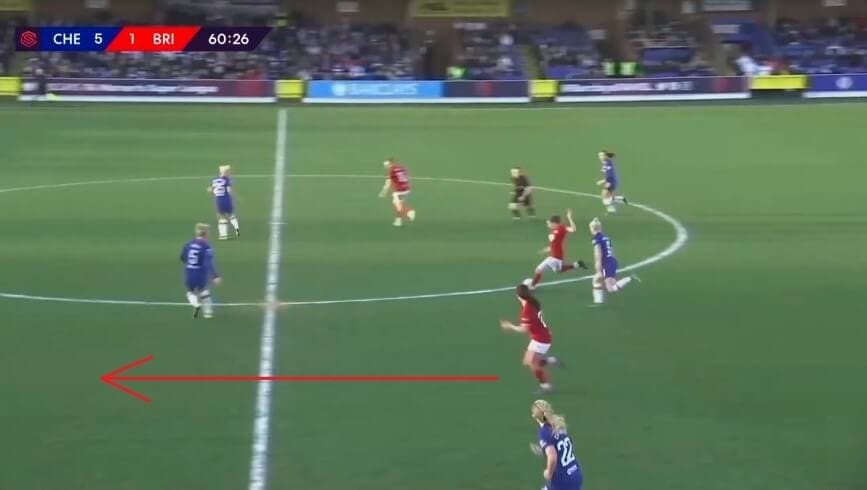
In this image, we see how Bristol City Women are facing the Chelsea Women midfield, and have to find a way past them. Chance is on the outside of the midfield and is looking to run around the defence, using the space in the wide channel, as indicated by the arrow. By making this run, Chance has enabled Bristol to play the ball around Chelsea’s midfield, although they are not through on goal because the Chelsea defence still needs to be beaten, but is out of the picture. This is one such example when Chance has seen where the space is and is looking to enable her side to play around them.
The key point to take from this example is that Chance’s movement has enabled Bristol City Women to play the ball around Chelsea Women’s midfield, with very little chance of the ball being intercepted on its way through. Had Bristol been made to play the ball through the midfield, there was more chance of this happening.
Two more examples of Chance’s intelligence to see where to create space are seen below.
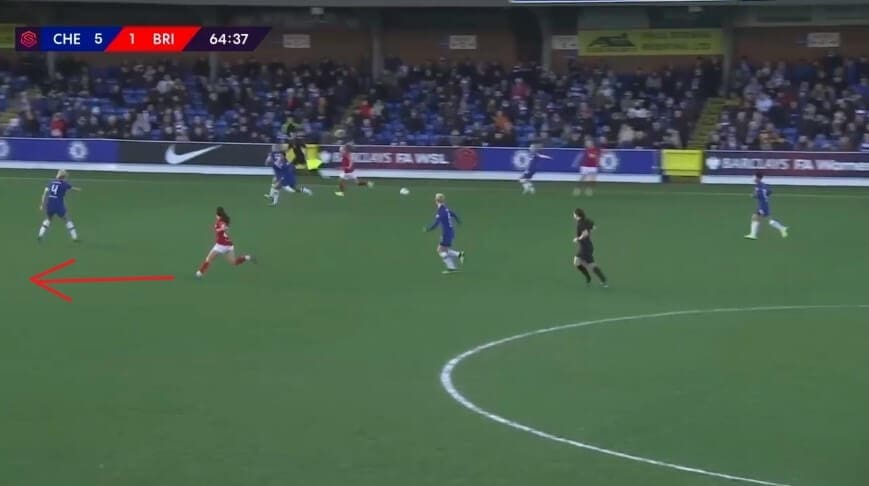
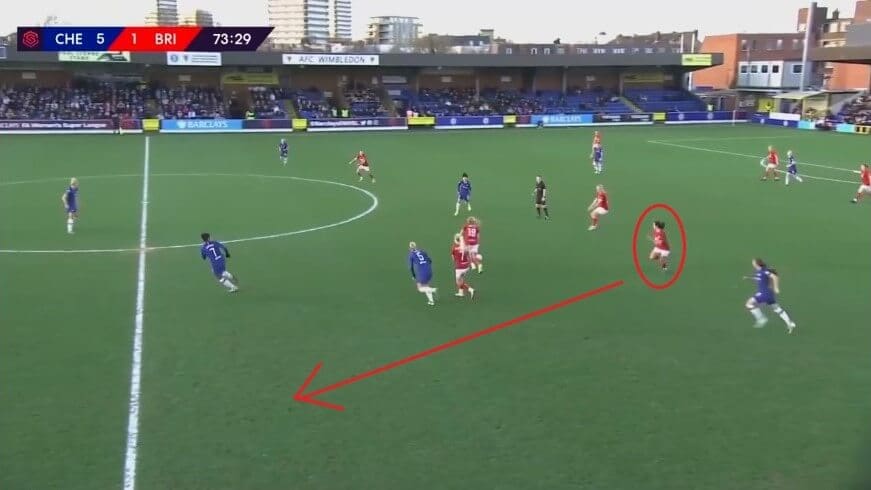
In both of these examples, we see how Chance makes runs into areas in order to give her team a passing option in a key area. By doing this, she allows her team to occupy more of the pitch, and to stretch the opposing defence in order to create more gaps. She is also running beyond where the ball is, because she wants to offer passing options going forwards, and her movements enable Bristol to continue to play the ball forward whenever possible.
It doesn’t matter so much if Chance doesn’t receive the ball in these spaces, because she is ensuring that the opposition have another thing to think about. You can see particularly in the second example how one of the Chelsea players is already watching Chance’s run, and this means it’s one less opposing player to crowd around the ball.
You can also see in both examples how Chance is running behind the defence, where they can‘t see her, and this is evident because of the Chelsea defenders’ body positioning. They have their backs to Chance when she is making these runs forward.
All of this means that Bristol constantly have a passing option in space, and this is important because it allows them to keep possession of the ball even when in tight situations.
Olivia Chance’s versatility also comes into good use on the pitch. So far, we have seen how she can play in the middle of the pitch and be effective with her positioning, and now we will see how she creates space with her play in the wider areas too.
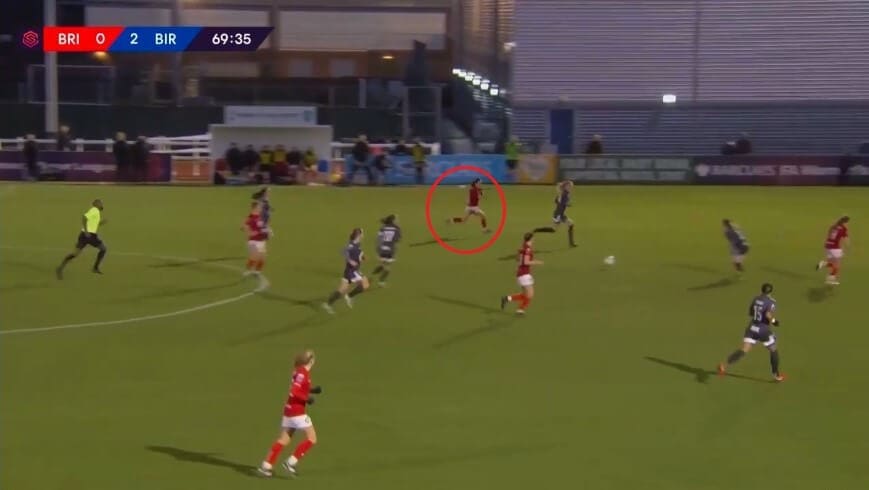
Here, Chance has taken up a position on the far side of the pitch. This means she can move behind the defence again, but also does something else. By taking up this position, she forces the opposing defence, here Birmingham City Women, to drift across a little whilst also having to stay central in order to block Bristol City Women’s main attack. This creates problems for the opposing team, and it is when gaps start to appear in their ranks.
Chance in this example doesn’t necessarily want the ball or need it, to be effective. Her thinking here is to make this run to offer her side a passing option, dragging the defence over towards her position, allowing her team to attack in the middle with more ease.
Finally in this section, we have this example.
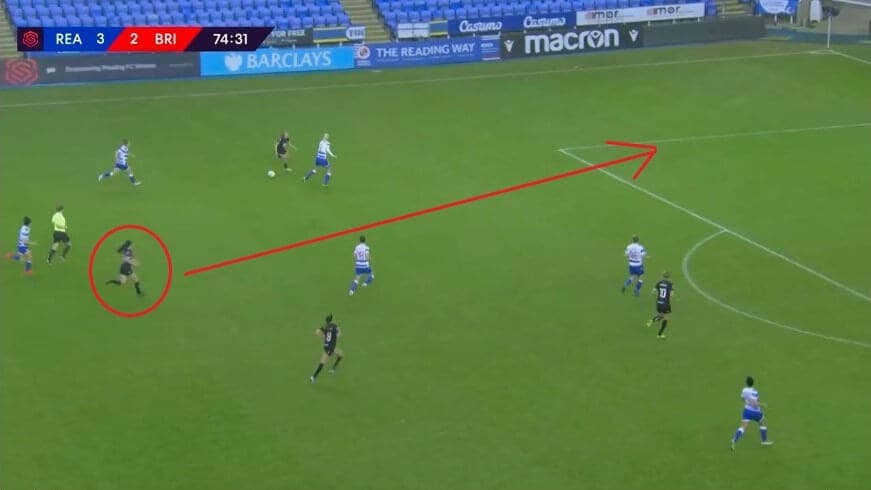
What this shows is how Chance runs through her team’s attacking line in order to confuse the opponents, here Reading Women. The instinct of the defence is to follow Chance, because she immediately becomes a threat when she runs into the area, with her movement indicated by the arrow. However, this is what Chance and Bristol want, and again this is an example of Chance not necessarily wanting the ball, but wanting to take defenders away from her teammates.
Creating goal scoring opportunities
We have now seen how Olivia Chance’s movement creates space for her team to pass to, but now we will see how her movement creates goal scoring opportunities for her team.

In this image, against Liverpool Women, we see how Chance is on the ball and is advancing forwards for Bristol City Women. There is space in front of her to do so, and she dribbles forwards before taking a shot that comes off the bar. That shows us that she is not only very good at moving without the ball, but also with the ball, and that adds another weapon to her individual arsenal.
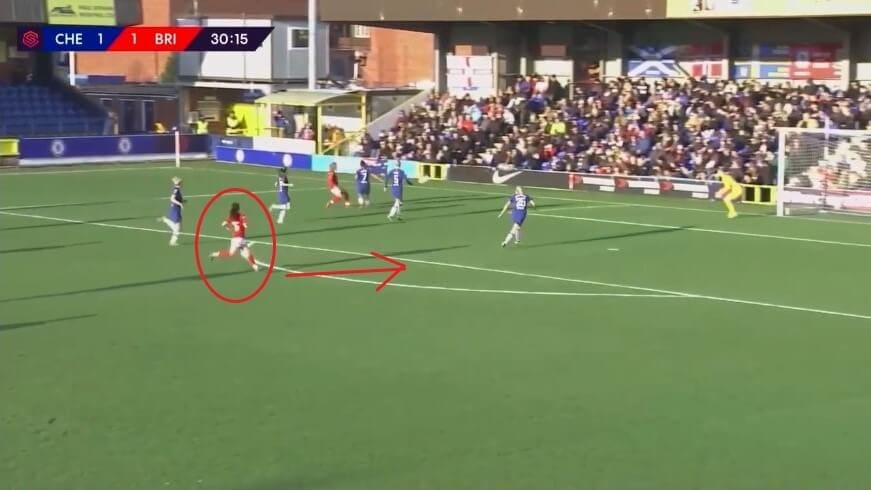
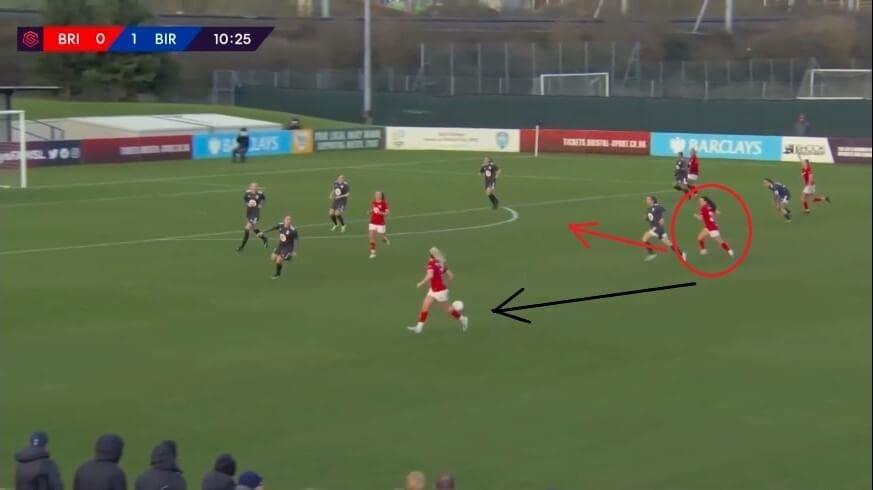
In both of these examples, Olivia Chance is looking to move into the central areas of the attacking third.
In the first example, she has seen that Bristol striker Ebony Salmon has been forced into a position on the left hand side of the box, and so she looks to move into the space as shown to offer a way of transferring the ball out of that tight situation. Again, you can see how she is moving behind the Chelsea Women defenders, therefore she is using her versatile positioning to be where she needs to be in order to affect her team’s play.
In the second example, again we see how she has passed the ball out towards Bristol City Women defender Poppy Pattinson, as shown by the black arrow, and is then looking to move into the goal area, as the red arrow shows. This is another way that she carries a threat to opposing defences, particularly in attack; her movement and eye for space enables her to position herself where she will be most effective to her team’s attacking tactics.
You can also see that where she is headed is an area in the middle of Bristol’s attacking line, and where there is currently no attacking player. This sort of movement is why Bristol tend to carry a good threat in attack. Strikers Charlie Wellings and Ebony Salmon may get the goals, but Chance is the player that fills the gaps and does the thankless and almost unnoticed task of filling spaces and affecting opposing defences, to the extent that gaps appear in their ranks.
Link-up with the strikers
The final section in this scout report looks at how Olivia Chance links up with the two Bristol strikers.
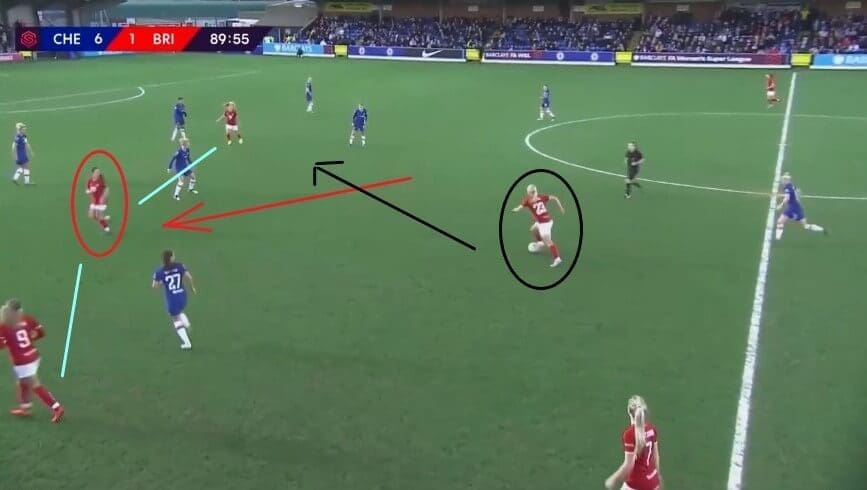
In this example, there are several things to mention.
Firstly, we can see how, like in the final point of the last section, Chance has moved to fill the gap in the middle of the two strikers. That shows how she sees where the space is and ensures it is occupied.
However, this particular movement also enables Bristol to attack centrally. To explain how, if you see where Chance and the Bristol front line are now, you can see how they are actually blocking off the main Chelsea defensive line, which means that Chelsea now can’t press forward and block the Bristol player in possession. Even those players who haven’t been blocked have to stay back, otherwise, they open up that Bristol forward line as passing options.
Therefore, the Bristol player in possession now has a small distance where they can dribble forwards with relatively no opposition. This has all come about because of Olivia Chance’s movements across her path, taking the defenders away and creating the space for her.
The next image shows a similar situation.
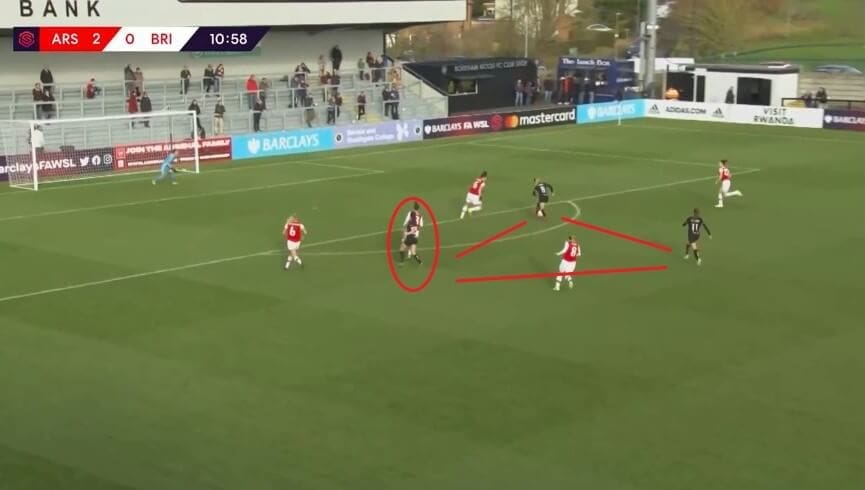
Here, against Arsenal Women, Bristol have managed to form a triangular shape in between the Arsenal defenders. This might seem like Arsenal have control of this situation, because they have surrounded them, but in actual fact, it is Bristol who are in control here. Olivia Chance is circled, and you can see how she has moved forwards to be one of the two most advanced players in this situation.
That means that Bristol can now spread apart and make the pitch as wide as possible, which is what they are trying to do. Arsenal must go with those players, otherwise, like with Chelsea in the last example, they risk opening up passing options for Bristol to use. You can already see the gaps between the defenders appearing. Whilst this is not necessarily due to Chance’s movements entirely, she was a big part of this coming about.
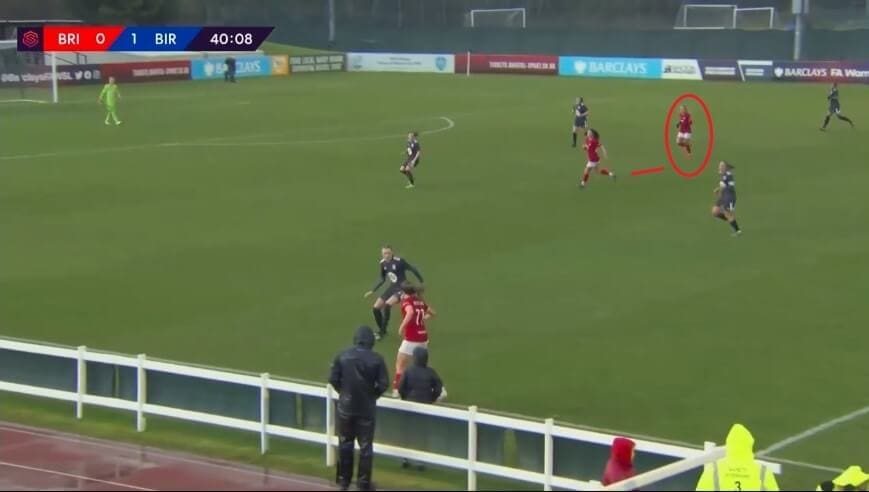
In this example, you can see again how Chance has advanced forwards to become part of the forward line for Bristol City Women. As we have already seen in this tactical analysis that she can play in any area of the midfield, we now add to the analysis that she can play equally as well in the forward areas as well, increasing her importance to Bristol’s tactics. By having a player who can play in all of these areas, and who can make a difference, Bristol can ask her to do any job that might need doing, and she could do it.
The final point to make links in with this, and it is that, whilst this section is looking at Chance’s partnership with the forward line, she links up with Ebony Salmon a lot of the time, and this is what enables Bristol to carry their attacking potency.
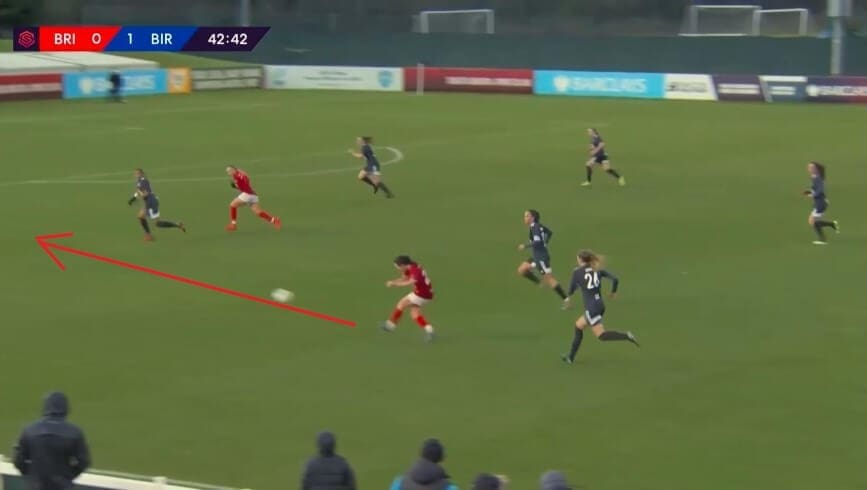
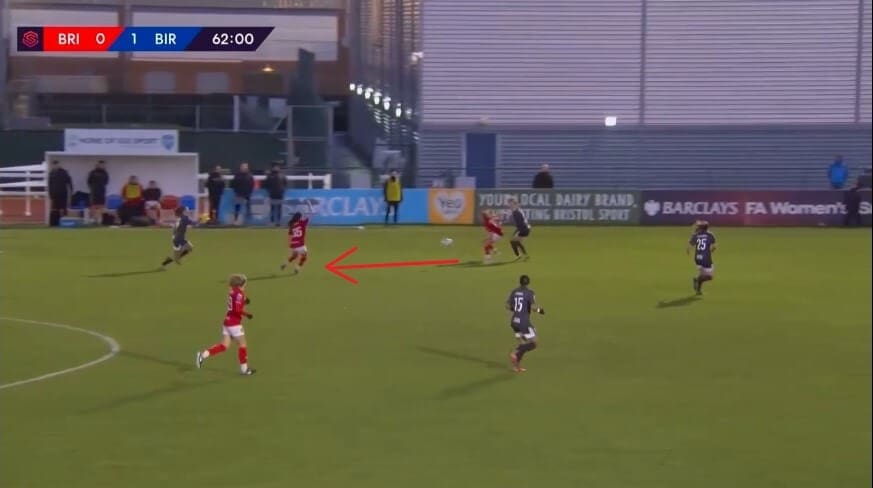
In these examples, we see how Chance is always positioned closely to Salmon.
In the first example, we see how Chance is playing the ball behind the Birmingham City Women defence. We know Salmon is very good at getting into attacking areas by playing through the middle of defences, and with Chance’s good pass here, Bristol now are able to attack and shoot at goal.
In the second example, Salmon has won the ball in a high position but with her back to goal, which means she can’t turn and run with the ball easily. Instead, she knocks it back to Chance, who has come to meet her in that area, and that ensures Bristol keep possession of the ball, even when they are unable to attack. With Chance playing this role, it frees up the other Bristol attacking players to then get into good positions, and Chance then has passing options to move the ball to, and the attack can continue.
These are the reasons why Chance’s partnership with Salmon is important. Their understanding and knowledge of each other’s games ensure they can be where they need to be, and the other Bristol players can also position themselves in areas around the pitch, rather than having to move towards Salmon to help her when in situations like the second example.
One thing she needs to work on is her end product. A little like with all Bristol’s attackers, we have seen how many times they get into good positions, but they need to take more opportunities. Bristol have only scored nine goals in their 14 matches, and that has been the problem for them this season; they have had some really good build-up play, but no reward. If each player weighed up the chances they have missed, and whether they were good opportunities, then they could have taken a few more points and been higher up the table.
Conclusion
To conclude, Olivia Chance is very important to Bristol City Women. She is one of the main reasons that they were not in the relegation zone when the season was brought to an end, and are in a good position to stay up, even when the FA decide about who, if any team, will be relegated. Chance creates space in attack and in the midfield and can play wherever her team need her to be. It is not hard to see why Bristol play well when she is in the team.





Comments